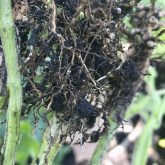Steve McQueen says you should treat your soybeans like corn. No, not exactly the same, such as with split nitrogen applications or fungicides to thicken stalks or stems. But the agronomy manager for Alpine says growers could apply the same diligence to improving soybean performance as has become the norm in corn.
McQueen says he’s made several discoveries in the past 12 years working with soybeans and potassium, and like phosphorus, sulphur and boron, it’s often an overlooked and underappreciated nutrient.
McQueen says one of its key functions is to regulate stomatal opening and closing, described as a “poor man’s irrigation.” He says potassium is responsible for 60 different enzymes, and along with molybdenum, helps nitrates turn into amino acids that develop proteins. It also moves nutrients into the plant, and although it does not become part of its chemical structure, it amplifies turgor pressure, lignin development, cell wall strength and stress management, and affects size and quality of grain. If plants are K-deficient, photosynthesis rates and production of adenosine triphosphate (ATP) are reduced.
Read Also

Sensing the soil: Root cell research finds ‘stress hormone’
Research into how root cells react to soil stressors could help plants better adapt to changes in their climate.
“Most people ignore potassium because we either have lots, or when it’s cheaper you throw lots on and you don’t worry about it,” McQueen says. “I always made sure that I put a lot of dry-broadcast MAP and potash on my soybeans, knowing I’d have a lot left over for my wheat in the fall. It just takes a large chunk of a year before it’s available to a soybean.”
McQueen’s experiences with soybean production date back to the 1980s when he was growing Maple Arrows and harvesting 45 bushels per acre. Before the advent of Roundup Ready technologies, he was growing 60-bushel soybeans on virgin soils on his farm south of Ingersoll, Ont. He’s been working at refining and defining his own best management practices for soybeans since, and joined Alpine two years ago to share the expertise he’s gleaned in the field.

McQueen began looking at more soil sampling and worked to understand that with base saturation rates below three per cent, applications of liquid potassium were making a difference. He wasn’t as concerned with the parts per million as he was with the available nutrition in the solution. He began testing potassium carbonates, studying K levels in the soil and if he noticed they were down, he’d start tissue sampling. In those samples, he could see it was low through the entire reproductive season.
McQueen says that’s not a surprise, considering his work indicated very few plants “ask” for nitrogen ahead of potassium.
“If you look at corn, it asks for potassium far more than nitrogen. Corn, soybeans, canola — all of a sudden when you’re looking later in the season, the demand for potassium is huge.”
From there, McQueen started to work with amino acids and biochemistry and decided to try Alpine’s Bio-K (potassium acetate). He says the product amplifies the plant’s ability to use K more efficiently and meet its genetic potential.
The goal is to increase the ability of a pure form of nutrient to get into a plant, which increases its ability to enhance exudate. The exudates enable the micro- biology to release more nutrients. Then the plant can take them in more efficiently. McQueen calls this his “uninhibited chain reaction” — he wants to create that process to increase the nutrient flow so microbials are more active and feed- ing nutrients to the plant. The plant feeds itself, then comes back to feed the roots. The increased activity creates more root tips and when he can see 25 to 100 per cent more tips, he knows he’s increased the life in the soil.
Season-long nutrition
McQueen says he has determined that contrary to many conventional “all-up-front” fertility plans, soybeans respond remarkably well to late-season applications. By enhancing the root capacity later in the season, it initiates a cascade effect to maximize fertilizer efficiency.
“We want to keep that plant moving throughout the season and you could apply potassium acetate every 21 days,” he says, adding that most growers likely wouldn’t follow such a plan. “We can fit it into any stage of a cropping program but need to target the higher-stress activities when we’re looking at going from vegetative to early reproduction. We want to fit it in at every point of excessive stress in the plant.”

McQueen says that when he looks at removal rates, he sees the uptake of potassium is considerable in a soybean plant, and it’s necessary despite what might be happening with nitrogen levels. Potassium levels have to be higher, even later in the season, to move nitrogen around the plant, because that’s a requirement when growing soybeans for oil and protein.
“I want to be proactive in positioning products, not reactive,” says McQueen. “I believe someday growers will add fungicides to a foliar program instead of a foliar being attached to a fungicide program. I can create plant health through natural devices, and when you keep a plant healthy and keep potassium levels in great places, you enhance natural systemic acquired resistance.”
– This article was originally published in the October 2022 issue of Soybean Guide.
















